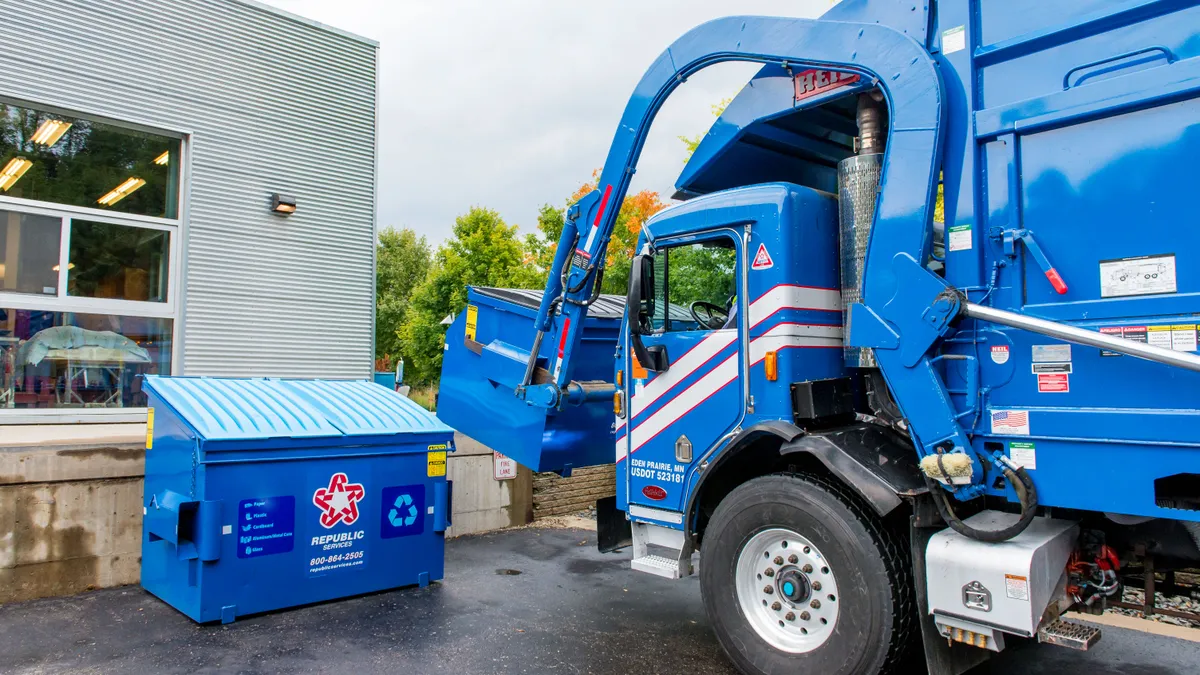Business leaders across the economy struggle to meet circularity goals when they lack proper investment or adequate tools to measure progress, according to a new survey from Republic Services and The Harris Poll.
Republic released its findings Wednesday in a report that includes its Circularity Index, which identifies what the company describes as solutions for better materials management.
The index pitches Republic Services, which serves about 13 million customers across roughly 1,000 locations in North America, as a partner in companies’ moves toward circularity. Republic has been investing in its recycling and hauling infrastructure, including by opening “polymer center” recycling facilities capable of breaking down plastic packaging. Its high degree of visibility into customers' disposal habits gives it the opportunity to target materials that go to disposal in landfills or incinerators and offer an alternative.
"As a key player in the circular economy, we are strategically focused on expanding recycling volume through innovative material handling processes and programs to help our customers achieve their goals related to sustainability and environmentally sound waste practices while also generating an appropriate return," the company noted in its annual report.
Executives on Republic's sustainability team discussed the findings of their Circularity Index, which surveyed 1,200 sustainability officers across 10 industries, on a webinar Wednesday. The index measures a company’s progress versus its industry peers on three metrics:
- Commitment, which tracks “the extent to which leadership, resources, goals and budget are aligned with circularity-related initiatives.”
- Execution, which tracks “how well an organization plans, implements and measures their progress to achieve their circularity goals.”
- Recovery, which tracks “the degree to which an organization’s circularity programs are achieving waste minimization and diversion, along with increasing material reuse and recycling.”
A company can reach one of five levels in each category, but the survey found that 45% of all respondents fell into the first two levels, indicating they have “novice” or “emerging” status in achieving their circularity goals.
Through the survey, Republic’s sustainability team found that respondents sometimes overestimated their recycling commitments. A sizable majority of respondents in the early stages of achieving circularity said that they had implemented recycling across all of their facilities, but Republic's internal data shows only about 20% of its customers have recycling services.
"Those numbers aren't exactly adding up," Kristin Steiner, director of sustainability solutions at Republic, said on the call.
That "reality check" could be addressed with a more thorough accounting of a company's materials management practices, Steiner said. She described waste audits as an essential first step to recognize where a company's opportunities for circular improvements lie. The Circularity Index found that 87% of respondents say they're tracking diversion, but only 19% are calculating and publishing diversion rates, which could lead to a lack of accountability.
Once sustainability officers have identified their company’s opportunities for improvement and a reasonable metric for success, companies need to authorize spending to meet their goals, according to Tony Fritz, Republic Services’ director of sustainability.
"Putting capital to work is a key sign that a company is truly committed to a strategy," Fritz said.
Following an audit, prioritizing items that are high volume or high weight will make a difference, especially if a company has a weight-based diversion goal. The kinds of investment necessary to target those items could include a baler or compactor, floor space, training or added processing or hauling fees.
Some industries, particularly the consumer packaged goods and energy and utilities sectors, are leading on circularity, according to the report. Republic's leaders said this was due in part to a sophisticated regulatory environment, where programs like extended producer responsibility and minimum standards for postconsumer recycled content have driven innovation.
Companies hoping to catch up to those leaders can use the Circularity Index as a guide which provides case studies of successful circular initiatives. Fritz said those examples are emblematic in the “long-tailed opportunity” of taking the process of achieving circularity in stages — starting with certain materials or opportunities like plastic reduction and working outward from there.
“Change is good,” Fritz said. “These all started as strongly performing industries, but working through a circular model gave them opportunities to be even better so they could save on costs and save on their emissions.”
Republic Services also released a modified form of the assessment it used to create the report that anyone can complete online to determine their current level of circularity.
Like some of its other large peers, Republic also offers consultations for companies looking to go deeper on improving their circularity.











